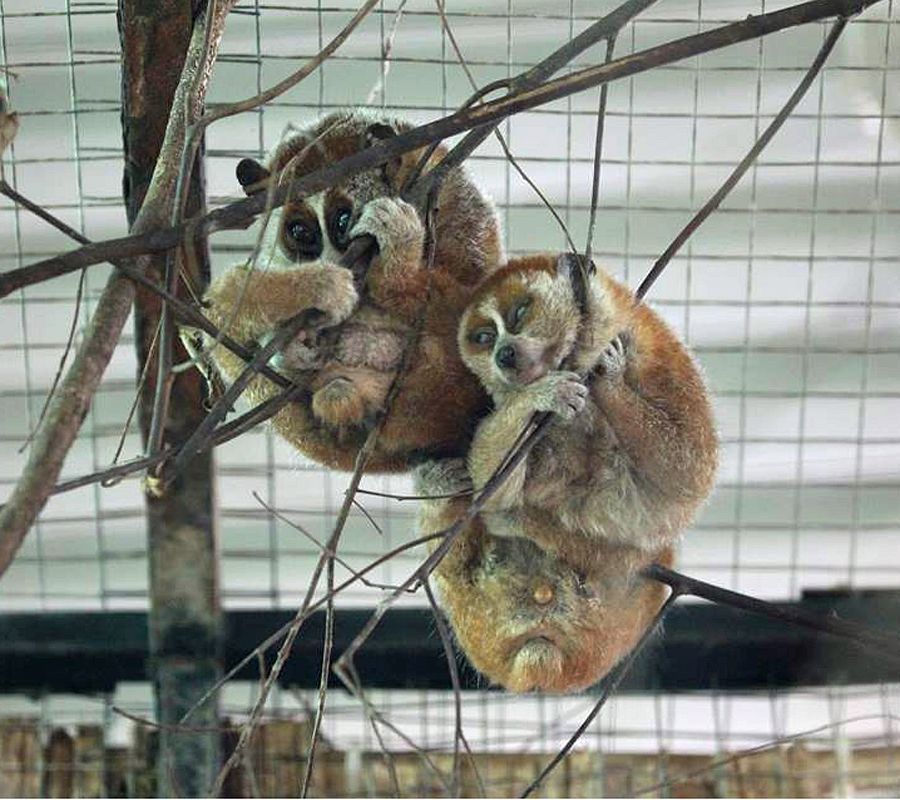A drop of the animal’s blood renders the soil barren; entire mountains can crumble and collapse where it landed. Be wary of this slow wayfarer of the forest, for if you catch sight of its glowing eyes in the distant darkness, your trip is doomed and should be abandoned immediately. And if someone brings one back to the village, make all efforts to return it to the jungle, lest you invite sorrow and ruin into your home. Don’t let its meagre stature, a mere 500 grams, and slow, cuddly demeanor confuse you; the cu li guards the gates to hell.
In the year 2025, when all the blank spaces on the atlases have been filled in and any animal’s genome can be mapped, the local myths that surround cu li (slow loris) seem absurd. Yet, these legends are no less misguided than our current understanding of the creature, as evidenced by the way we treat them. Rather, to this day, cu li remains frustratingly misunderstood.

Pygmy slow loris (cu li chậm lùn). Photo via BBC Science Focus.
The trouble with names
Confusion about the slow loris starts with its name. The English name comes from the Dutch word “loeris,” meaning clown, which makes sense because all eight slow loris species have facial markings similar to clown makeup, and the “slow” accurately describes the speed at which they meander along tree branches, particularly if observed during the daytime.

Illustration of the pygmy slow loris by J. Lewis Bonhote for the 1907 description of the species. Image via Wikimedia.
The Vietnamese name, cu li, is more troublesome. The term is most commonly associated with its historical usage to describe unskilled laborers. In that context, cu li is a modification of the word coolie, which is itself likely a bastardization of the Hindi and Telugu word kulī (कुली) or (కూలి), meaning “day-laborer,” which was used by westerners in Asia during the long and bloody colonial period in the region, including France’s time in Vietnam. While cu li today rarely denotes a position of unskilled (and abused) worker in Vietnam, it is sometimes used in the north to criticize someone as stupid and stubborn. We’ve been unable to ascertain if those definitions resulted in the animal’s name, though an expert at Đảo Tiên Endangered Primate Species Centre told us that some places in Vietnam call them “lười” (lazy) or “cù lần” (stupid) because they are slow and sleep during the day. Further complicating matters is the existance of a plant also called cu li, which the slow loris does not feed on.
“While it looks like it is experiencing bliss, a cu li being tickled is actually furious and preparing for violence. Cu li have poison-secreting glands in their arms, so what looks like a cute, smiling primate is actually a deeply upset animal being tortured.”
I first became aware of cu li’s muddled meaning when the film Cu Li Never Cries (Cu li không bao giờ khóc) was released last year (more on the movie later). Some friends had seen the title and assumed it was a period piece about the mistreated workers involved in colonial projects and therefore didn’t see it. The misunderstanding led me to ask numerous friends if they knew what a con cu li was. No one had.
So, for any readers in the same position, briefly, cu li are primates native to South and Southeast Asia. They are more closely related to lemurs of Madagascar than any monkey or ape, and having evolved more than 10 million years ago, they are sometimes thought of as “primitive” primates that have not developed the same level of intelligence or complex social structures as their ape peers. Special capillaries in their hands and feet allow them to hang on tree limbs without losing feeling, enabling them to move at such a slow pace as to not disturb foliage and attract predators. Camouflage is their greatest means of defense when going about at night, solo seekers of tree sap, which can constitute 70% of their diet, along with insects and fruit.

Bengal slow loris (cu li chậm Bengal). Photo via Roundglass Sustain.
Vietnam is home to two slow loris species: the pygmy slow loris (cu li chậm lùn), which lives west of the Mekong River in much of Vietnam as well as parts of Laos, eastern Cambodia, and China; and the Bengal slow loris (cu li chậm Bengal), which has a broad range across Southeast Asia, including northern Vietnam. True to its English name, the pygmy slow loris is the smallest species, reaching just 19–23 cm long and weighing less than 500 grams. Living 10 to 20 years in the wild, they prefer solitary lives or groups of four or fewer individuals. Unlike the commonly imagined behavior of monkeys, cu li cannot swing or leap between branches and instead walk along branches, preferring never to step foot on the ground.
A problematic place in pop culture
Even if you didn’t know you were looking at a cu li, you might have come across one on social media. Several years ago, they became quite popular online, with a particular craze of tickling them spreading across the web. When tickled, cu li raise their arms, and their already cherubic faces contort into even more awwww-inspiring adorability.

While it looks like it is experiencing bliss, a cu li being tickled is actually furious and preparing for violence. Cu li have poison-secreting glands in their arms, and they lick them to add venom to their already poisonous saliva as a means of protection. So what looks like a cute, smiling primate is actually a deeply upset animal being tortured. The bite can be extremely painful and cause allergic reactions that result in necrosis, forcing a person to lose a finger, hand, or even arm, the toxins are slow acting and thus not useful for hunting. Rather, it's mostly effective for inter-species squabbles and a natural pest repellent. Cu li are one of the few mammals and the only primate to have a poisonous bite, which should be a source of fascination, but people seem more interested in oooo-ing and ahhhh-ing at the conventionally cute appearance.
While the tickling trend has seemingly tapered off, there is no slowing of their popularity in the pet trade. Especially in Japan, where endangered animal laws are routinely skirted and cuteness is highly praised, cu li have become popular companion animals. Of course, they make terrible pets. Owners remove their teeth to ensure they cannot bite, and beyond that, their natural behavior and instinct are wholly unsuited to private homes. Unfortunately, videos often show them in such decontextualized settings, leading viewers to assume that keeping one in a private dwelling is anything but cruel.

Scene from the movie Cu li không bao giờ khóc. Photo via Film at Lincoln Center.
And this brings us back to the previously mentioned Cu li không bao giờ khóc. I do not think we need to make art that delivers public service announcements, but it should be mindful of the messages it may be inadvertently spreading. The film’s subplot focuses on a woman returning from Europe with her deceased ex-husband’s pet cu li. The creature, mercifully an animatronic model, is paraded about in the daylight as one would a fashion accessory with no veterinarian care provided for its discussed skin condition, and kept in a cramped Hanoi neighborhood that surely wouldn’t allow for an appropriate diet. Frustratingly, the film does nothing to discourage people from owning them as pets.
Conservation efforts against depressing odds
While the pet trade, both domestic and international, threatens cu li, so does hunting it for use in traditional Chinese medicine. It should surprise no one that cu li meat, bones, and even toxins are consumed as treatment for a long list of ailments, ranging from stomach pains to post-pregnancy fatigue to broken bones and even STDs. Little different than the rhino bones taken to make men’s dicks hard, there is no scientific support for consuming cu li as medicine. Ironically, the golden chicken fern (Cibotium barometz) which shares the Vietnamese name cu li, is also taken as traditional medicine to treat back, joint, and bone pain, with scientific studies validating its use as an anti-inflammatory with anodyne properties. It’s thought that people confusing the use of the word cu li furthers the erroneous belief that consuming the animal offers restorative health effects.

Three rescued cu li chậm lùn at Đảo Tiên Primate Rescue Center. Photo via Go East Asian Species Trust.
The pet trade, poaching for medicine, and widespread deforestation from a variety of causes — including farming, mining, and logging — across the cu li chậm lùn’s range, put them in serious danger. Listed as endangered in the IUCN Red Book, experts suspect their population has declined by more than 50% over the last 24 years. Vietnamese law restricts possessing a cu li for any purpose with significant fines of up to VND30 million for illegally keeping one and up to VND15 billion and 15 years in prison for transporting, capturing, or killing endangered wildlife in general. Still, ignorance and greed continue to result in cu li being abducted from their natural environments and kept in unsuitable conditions. If rescued, there is thankfully potential for successful rehabilitation and release under the guidance of organizations such as the previously mentioned Đảo Tiên Primate Rescue Center outside Cát Tiên National Park and the Endangered Primate Rescue Center (EPRC) in Cúc Phương National Park. In addition to their expertise in knowing how and where to re-release the animals, they concern themselves with public education. They have a lot of work to do.
Release of a cu li in Vietnam. Video via Endangered Primate Rescue Center.
Ultimately, our inability to understand the cu li underscores the motivation behind Saigoneer's Natural Selection series. Animals do not exist to be our amusements, our medicine, our omens, or our food. We will never understand them if we think of them solely in their relation to people. If we cannot simply observe them, marveling at their complexities, then it’s better we don’t know they exist at all. I hope the world remains large enough for dark and secluded forests to provide cu li space to quietly live out their lives in peace, eyes like the distant, dark side of the moon.

















